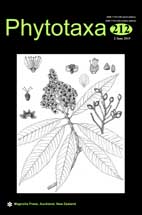Abstract
A new species Mensularia rhododendri is described from southwestern China on the basis of both morphological characters and molecular evidence. Phylogenetic analysis based on nuclear large subunit (nLSU) ribosomal RNA gene shows that the new species belongs to Mensularia. Morphologically, the new species is mostly similar to Mensularia hastifera by sharing similar hymenial setae and basidiospores in shape and size. However, M. rhododendri differs in smaller pores (5–6 per mm), thinner fruit body (up to 2.5 mm), shorter and unbranched hyphoid setae (up to 110 µm long) present in trama only, basidiospores not collapsed, and growth on Rhododendron in nearly the timber line of southwest China, while M. hastifera has relatively larger pores (3–4 per mm), thicker fruit body (up to 10 mm), longer and sometimes branched hyphoid setae (up to 300 µm long) frequently present in both trama and dissepiments, and mostly collapsed basidiospores, and occurs mostly on Fagus in the temperate area of Central Europe. The morphological differences between M. rhododendri and other similar species of Mensularia are also compared.

